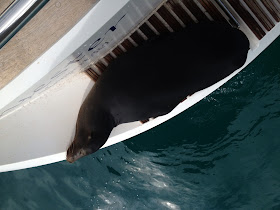May 4, DEPARTURE DAY
LAP-O-LUXURY The InterContinental Beach Resort was just what the doctor ordered! A beautiful beachfront bungalow that was steps away from a sandy beach on a quiet snorkeling lagoon which connected to the sea. A king sized bed-that didn't rock---, air conditioning and clean sheets...it was wonderful!! We even watched few minutes of CNN, our first TV since Panama, and learned the Dow hit 15,000. The laid back elegance of the resort was just perfect for our three night stay. We slept 10 hours the first two nights it was SOOO relaxing. And it was wonderful sleeping together again (am I getting too personal here?) without feeling sticky and sweaty, made worse on the boat from feeling the body heat radiating from your partner in a too-small berth.
 |
| Our beach bungalow on the lagoon with snorkeling & A/C |
LAP-O-LUXURY The InterContinental Beach Resort was just what the doctor ordered! A beautiful beachfront bungalow that was steps away from a sandy beach on a quiet snorkeling lagoon which connected to the sea. A king sized bed-that didn't rock---, air conditioning and clean sheets...it was wonderful!! We even watched few minutes of CNN, our first TV since Panama, and learned the Dow hit 15,000. The laid back elegance of the resort was just perfect for our three night stay. We slept 10 hours the first two nights it was SOOO relaxing. And it was wonderful sleeping together again (am I getting too personal here?) without feeling sticky and sweaty, made worse on the boat from feeling the body heat radiating from your partner in a too-small berth.
 |
| Moorea |
TATOO! Jan had been talking the entire trip about getting a tattoo when we finished our trip, but always in uncertain, questioning terms. With much encouragement she finally decided it was the thing to do to commemorate this amazing voyage. We asked around and learned that the husband of one of the concierges at the resort had a fine reputation for doing wonderful, safe and painless tattoos. We borrowed bikes and rode the 4k to his "house" by the road and discussed the process and location and design with him, and made an appointment to return the next day for the deed. Jan awoke the next morning with stage fright but was convinced that it had to be done, "Now or never". So we rode the bikes again to Roberto's house and she sat for a half hour while a lovely flower design was tattooed on her right shoulder. When asked what it stands for, we're told it represents love, family and "your story", which in Jan's case is the 5,000 mile voyage across the Pacific.
HEADING HOME We caught the 12:30am flight out of Papeete to Hawaii this morning (Sunday), then switched planes to LAX, and I'm writing this final blog on the flight to Denver where Megan will pick us up at 9:30pm and house us for a few nights so we can adjust to the altitude and celebrate Jan's (and Andy's) birthday on Tuesday. It will be so fun to reconnect with our families and especially our grandsons. And we're also looking to catch up with you long suffering blog readers, our good friends.
THE END And so, the Great Adventure comes to an end. We have so many memories and so many pictures! As I've already stated, the magnitude of what we've just accomplished is overwhelming for us and we're so grateful to have had the opportunity. Sailing 5,000 miles over the open ocean has been mind-boggling and visiting all those exotic locations has been such a learning experience. But enough of tropical paradise for us for a while. We're looking forward to the cool, dry Colorado climate!!!
Thank all of you for following us. We've felt you keeping us company and loved having you along. We'll work on getting our pics online soon so you can see more of the beautiful places we've been.
























.JPG)

